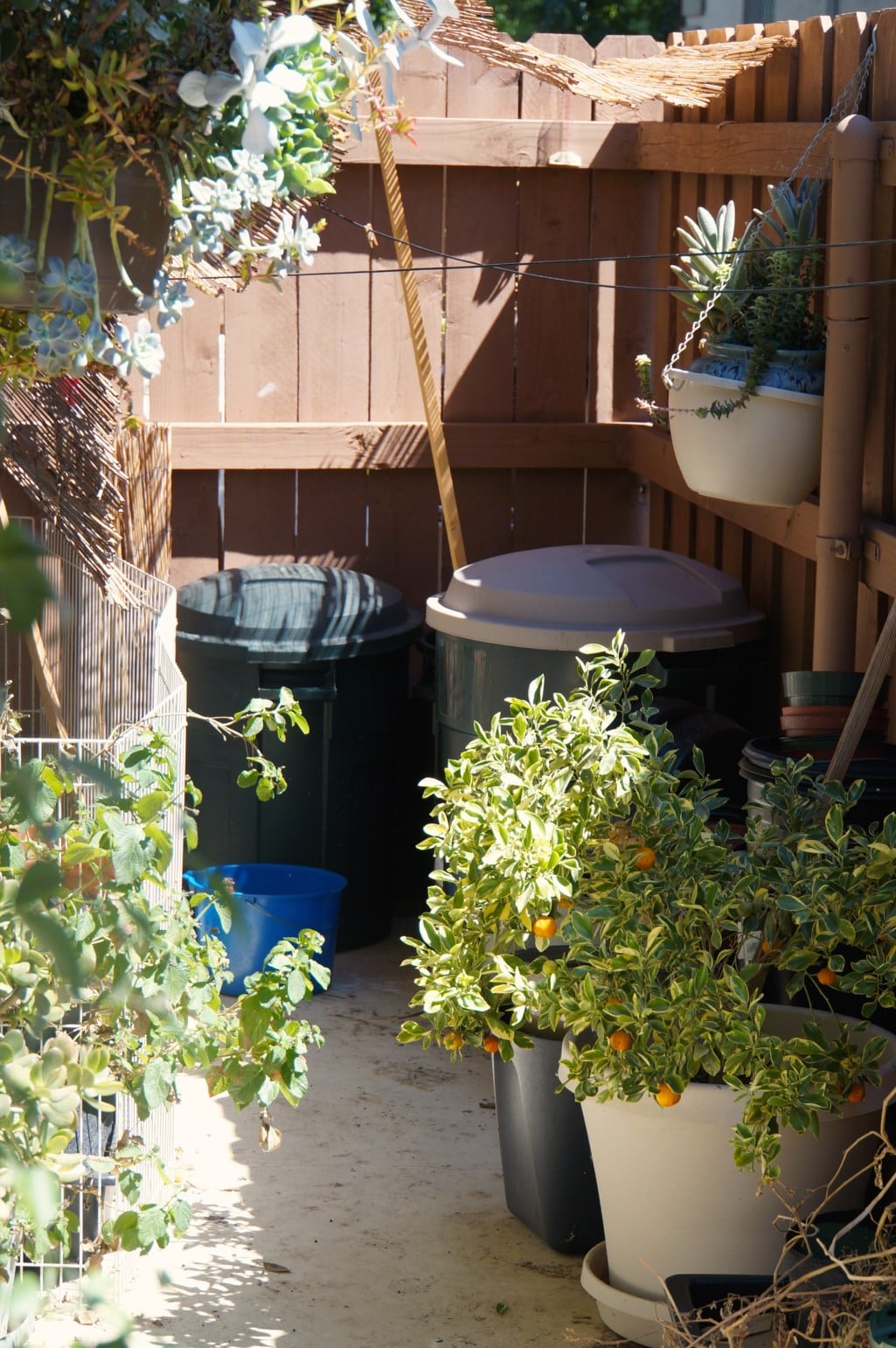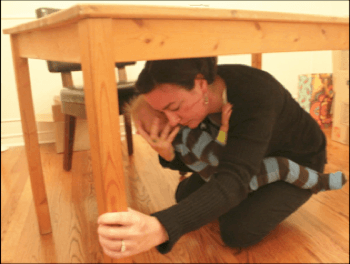Your Family Can Be Ready For SoCal’s Next Big Earthquake

Welcome to L.A. Parent’s earthquake readiness page. We’ve compiled this handy guide because, when we’re talking about a major earthquake hitting Southern California, it’s not “if,” it’s “when.” We want your family to be prepared. We cover a number of topics here, but have tried to keep it simple. Just click below to jump to the section you’re interested in tackling right now:
First, everyone in your family needs to know what to do when the ground starts shaking: Drop (to your hands and knees), cover (crawling under a sturdy piece of furniture or protecting your face and head with your arms) and hold on (because things – even large things – are going to move around).
To teach small kids what to do, Jeffrey Upperman, M.D., associate chief of pediatric surgery at Children’s Hospital Los Angeles and a member of the American Academy of Pediatrics National Advisory Committee on Children and Disasters, suggests making a game of it. “Make your home-safety activities part of the role playing or the game playing that you do,” he says. Consider a version of “musical chairs” where kids move around the house and drop, cover and hold on when the music stops. Play periodically, so the idea sinks in.
You might have been taught that it’s safest to stand in a doorframe, but Margaret Vinci, manager of the Office Of Earthquake Programs at Caltech, a focal point for earthquake information in Southern California and worldwide, says that hasn’t been true since houses were made of adobe. The doorframe won’t keep you safe, but will put you in the path of a swinging door. Dropping straight to the ground keeps you from being thrown off your feet, and makes you less of a target for flying debris. “The more movement you make, the more you’re apt to get hurt,” Vinci says.
You might also imagine, based on your experience in previous earthquakes, that you will be able to walk or run, or that you can get yourself outdoors and clear of buildings and power lines. But you haven’t experienced a quake of the magnitude we are talking about here, because we haven’t had one in California since 1857. The 1994 Northridge quake, most people’s point of reference for a large earthquake, was a magnitude of 6.7. “Unless they come from another country, they have not experienced a 7.8,” says Vinci.
During the recent Napa quake, most people were home in bed, but a quake could strike at any time. You might be at work or at the grocery store. Your children might be at school. You all might be driving in your car. You should be prepared for shaking in any of the places where you spend lots of time.
Take a look around these places. Are there bookcases or other heavy furniture that need to be secured, or heavy objects up high that would fall? Would mirrors or pictures come down off the walls? Take steps to secure them. Are there windows that would shatter? Where is the safest place to shelter?
If you are home in bed, would you have everything you need to navigate your shaken house in the middle of the night? Vinci’s solution here is simple and creative. She keeps an old pair of tennis shoes (which she saved when she bought new ones) in a bag along with a spare set of clothes and flashlight, and ties the bag to the frame of the bed so it won’t slide away.

Erin Burkett, staff scientist with the USGS, stores her backup water in large plastic trash cans secured on her porch.
Once the shaking stops, you’ll need supplies, and the first thing to think about is water. If you don’t do anything else, store water. Nothing will likely be coming out of the faucets for weeks, according to “The ShakeOut Earthquake Scenario,” a government report prepared in 2007 to describe the impact of a magnitude 7.8 earthquake on Southern California. Roads between you and the nearest water source could be closed, and emergency responders will be too overwhelmed to bring water to people during the days following a quake.
You should store at least 21 gallons of water for each person in your house, which is about a one-week supply. One way to do that is to store five cases of drinkable-size bottles of water per person, changing out the bottles every six months.
Erin Burkett, staff scientist with the U.S. Geological Survey’s Science Application For Risk Reduction project, stores her backup water in large plastic trash cans secured on her porch. “I tend to collect cold water in a bucket as I wait for my shower to warm, and transfer that water to the storage bins, and also scoop water out to water my house and garden plants,” she explains, “so the bins serve a few purposes for me, with backup water supply being an important one of them.” The bins have lids, and she cycles through the water at least once a month, so it stays fresh and drinkable.
There are also plug-and-play storage options, such as the 55-gallon barrel Vinci uses. They can be purchased from a variety of locations for less than $150 (search “emergency water barrel” online), and most come with an additive that will keep the water safe to drink for five years.
If you own your home, protect the 30-50 gallons of drinkable water in your water heater by ensuring that it is properly strapped so that it doesn’t tip over. Check manufacturer’s instructions about how to access the water safely.
There are online checklists (see below) to help you gather the rest of the supplies you’ll need. Upperman advises adding a deck of cards or a simple board game to the list because of an element people often forget – the waiting for power to come back on, for roads to open, for help. “Game playing could help pass the time,” Upperman says. “I think games are going to be critical.”
You could also involve your kids and make a game – like a scavenger hunt – of shopping for emergency supplies. “That could generate a discussion about preparing and what truly is needed for surviving,” Upperman says.
Prepare Supplies For Your Pets
Don’t forget to store supplies for your family’s pets. Aimee Gilbreath, executive director of the L.A.-based nonprofit Found Animals, says you’ll need five days’ worth of food (and a can opener if your pet eats canned food) and water, plus portable bowls, for each pet. “Families should also prepare a written feeding schedule that can be shared with others, if needed,” she says.
Also store a backup supply of any medications your pet takes regularly in a waterproof zip lock bag, along with vaccination records. Comfort items such as beds, blankets and toys will help keep your pet calm and cozy. And don’t forget cat litter, disposable litter boxes, plastic waste bags and other supplies you’ll need for clean-up. An extra leash for dogs could come in handy.
Plan for the possibility that your pet might get lost during an earthquake. Make sure each pet has several forms of identification. Found Animals recommends every pet have a collar with its license and external ID tag, as well as a registered microchip. “Disasters frequently displace hundreds of pets from their families,” says Gilbreath, “and the number-one reason they are never found is lack of permanent identification.”
It’s also important to think about where your pets would be able to stay if your home were severely damaged and not inhabitable following an earthquake. Not all emergency shelters or hotels allow pets, so call your local emergency management office or animal shelter to see if there are places planned for people and pets to stay together in the event of an emergency. Research pet-friendly hotels or have family or friends in mind outside of your area who could keep your pets.
Roads may be blocked by debris, freeways impassable because bridges and overpasses that haven’t been retrofitted have collapsed. Where roads are open, they’ll be jammed with traffic. (And do you have gas in your car and cash in your pocket? Gas stations won’t be pumping, and ATMs will be down.) Your family could be separated for hours or longer – and they won’t be just a phone call away.
An earthquake of “Big One” magnitude will knock out landline phone service and electricity. Cellular circuits, meanwhile, will be jammed with emergency calls. And once your cell phone battery runs out (or if the phone is damaged), any phone numbers you haven’t memorized will be lost.
To stay connected, you should:
- Have everyone carry a list of important phone numbers. Vinci suggests a small piece of paper tucked inside your cell phone case. For kids who don’t have a cell phone, Upperman says you can use a permanent marker to ink numbers inside a backpack or lunchbox.
- Include an out-of-state contact on that list. It will be easier to phone across the country than across town, and family members will be able to get messages to each other through this out-of-state contact.
Things might not be great, but knowing where your family is and what is going on will help bring everyone’s anxiety level down a bit.

An inspection by a reputable retrofitting company will help you determine whether your house will be habitable after a major quake.
“Earthquake” is a scary word. To homeowners, here’s another one: Retrofitting. Read on for some information that could save your home.
Your first question about retrofitting should be: Do I need it? Think of your house as a ship on an ocean of dirt. The foundation is the bottom of the boat, and the house itself is the deck. If the deck isn’t attached to the boat, imagine what happens when a wave (earthquake) hits. If your house isn’t bolted to its foundation, it is like that ill-fated boat.
An inspection by a reputable earthquake retrofitting company will give you some solid guidance. When seismologist Lucy Jones, Ph.D. – who currently serves as earthquake advisor to L.A. Mayor Eric Garcetti – wanted her home checked out, she called Ed Sylvis. Founder of Pasadena-based Seismic Safety Inc., Sylvis has been inspecting and retrofitting homes for more than 50 years. An inspection from Seismic Safety costs $100-$200, but comes with a written report explaining what you need to have done, what you don’t need to have done, and why. Homes most likely to need retrofitting work:
- Were built before 1985,
- Sit on a slope,
- Are more than one story tall or
- Are built from masonry (brick).
“The bulk of our work is bolting and bracing,” explains Seismic Safety Vice President David Johnson. This work, which secures a home to its foundation, will cost $4,000-$7,000. Replacement or “sister” foundations run $35,000-$45,000 and up. Even if you don’t do the work right away, you’ll understand what you’re up against. “The safest thing is to just know,” Johnson says.
Sylvis makes another point – that this investment could save your home, or even your life. And that if your house slips off the foundation, your other earthquake preparations won’t do much good. “You can’t go in and rescue those wonderful earthquake items you have if your home isn’t safe to enter,” he says.
The Earthquake Brace+Bolt program (www.earthquakebracebolt.com) has additional information and a listing of contractors. Sylvis also advises making sure anyone you work with has a current contractor’s license and worker’s compensation insurance, and avoiding anyone who asks for money up-front or wants to save you some cash by working without a permit.
And remember, these are just first steps. It will take Southern California months to recover from a major earthquake, and whatever you’ve done to prepare, there is likely more you can do. As Vinci points out, “It begins at home.”
Drop, Cover and Hold On: www.earthquakecountry.org/dropcoverholdon
Secure Your Space: www.quakeinfo.org
Water and Supplies: www.ready.gov/build-a-kit, www.espfocus.org





























